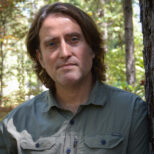December 3, 2014 — Limits to growth are a fundamental and widely accepted principle of sustainability. You might even call them the first law of sustainability. Nevertheless, as ecological economist Richard Norgaard first noted, limits make a terrible metaphor for sustainability. They don’t inspire vision; they only require restraint. They highlight what we can’t do — catch more than x fish or cut down more than y trees per year — but offer nothing in terms of how we might organize our lives such that sustainability isn’t a constant struggle. Limits are unavoidable, and their recognition is requisite to sustainability, but I believe that if people and communities are to develop new and transformative ways of living sustainably they need a metaphor that inspires not just restraint but creativity and innovation. The basis for such a vision, I submit, is found in a second basic principle of sustainability, one that requires us to allow, and even embrace, change. I call this principle the conservation of change, and propose it as the second law of sustainability.
The concept of limits derives from natural law — the first law of thermodynamics, also known as the conservation of energy. There is also a second law of thermodynamics, and whereas the first law is concerned with physical phenomena, the second law is organizational. Given that sustainability is fundamentally an organizational question — about how we organize our systems for resource use such that they can be sustained — the second law of thermodynamics is particularly relevant.
The second law of thermodynamics states all systems move toward maximum entropy, which is often described as potential or disorder. At first blush this law would seem to relegate the notion of sustainability to wishful thinking: If all systems move toward lower organizational complexity, then stability in any complex natural system, whether of a population or ecosystem or biome, would be short-lived. Yet, through cycles, nature has developed a solution to this tendency toward disorder. Cycles are the mechanism by which high levels of biological and ecological organization are sustained despite the fact that the matter and energy therein are inclined toward lower degrees of organization.
The more we manage for stability or uniformity in the organization of a complex social-ecological system, the more that stability will cost in terms of increased entropy elsewhere.
The boreal forest, for example, has been a coherent biome in the northern hemisphere for millennia, and this is the result of a vast and constantly unfolding patchwork of cycles at smaller scales such as fire-driven succession. Likewise, Canada lynx and snowshoe hares have long thrived as an important predator-prey dyad in the boreal forest, and this is again the result of the linked boom and bust cycles of the two populations. Indeed, wherever we see stability in natural systems, it is an illusion, an artifact of scale. The second law is not broken in these cases because change is conserved; it is simply occurring at smaller scales and levels of organization.
A restatement of the second law for the purposes of sustainability, then, is that change must always be conserved. The more we manage for stability or uniformity in the organization of a complex social-ecological system, the more that stability will cost in terms of increased entropy elsewhere. A case in point is the Gulf of Maine ecosystem, in which long-held lobster fishing practices have been remarkably effective in fostering a stable lobster population. However, the entropic cost of that stability has been borne out in the simplification of the broader Gulf of Maine food web, which is best characterized as a lobster monoculture that is extraordinarily vulnerable to change.
To avoid such outcomes, the conservation of change requires that we abandon this fixation with sustainability as a matter of keeping things uniform and stable. Change must happen somewhere in the system. Ignoring or resisting change is a path to collapse; rather, we need to learn to steward change — to roll with the proverbial punches by building flexibility and diversity into our lives and livelihoods. Instead of trying to engineer year-to-year consistency in a cod or salmon or lobster population, we should look for ways to adapt and diversify our fisheries and markets so that both communities and ecosystems are resilient over the long term.
Traditional food systems are an excellent example. Numerous “seasonal round calendars” have been documented for indigenous cultures from around the world, each representing a portfolio of food options that enabled these cultures to thrive for millennia despite short and long cycles of variability in climate and in fish and game populations. Historically, tribal peoples were flexible and their livelihoods were adapted to moving across the landscape in a way that worked with, rather than against, change. Short-term food shortages did occur, but it is only since the forced transition to living in fixed residences and extensive loss of territories that many indigenous peoples must contend with chronic food insecurity.
The problem is not one of insufficient data or inadequate models and management technologies, but of unnatural expectations for uniformity in the “services” ecosystems can provide.
Many of western societies’ market-oriented goals for sustainability work at cross purposes with living flexible and adaptive livelihoods, in that they are intolerant of the vagaries of natural variability and change. As a result, many people continue to seek ways to engineer nature into standardized and consistent systems of production rather than looking for ways to integrate our lives and lifestyles within the cycles of the world around us. The limits-to-growth metaphor does nothing to challenge this mentality. It simply contributes additional parameters to existing industrial approaches, fostering mechanistic solutions for sustainability that are applied one resource at a time.
The success of such approaches has been spurious at best. In cases like the Gulf of Maine, the signs of wear are easily found in the degraded state of the surrounding ecosystem. In other cases, such as the fisheries in Alaska where I do my work, the consequences are more nuanced, borne out in terms of social and environmental injustice and bitter conflicts that divide local communities. In all cases, I submit, the problem is not one of insufficient data or inadequate models and management technologies, but of unnatural expectations for uniformity in the “services” ecosystems can provide.
As a metaphor for sustainability, the conservation of change requires that we think about sustainability not as a technological challenge, but as a matter of cultural growth and co-evolution wherein we embrace change, implement it in our technologies and embody it in our lifestyles. Efforts to eat seasonal local food are a straightforward example at the individual level, as are efforts to diversify among small-scale commercial fishers — though these both face uphill challenges in a world still dominated by industrial and growth-oriented mind-sets. Ultimately, what the conservation of change tells us is that the more rigid our expectations for the natural world, the more we are sure to be disappointed and the more damage we are likely to inflict on ecosystems and on ourselves. The more flexible we can learn to be, however, the better our prospects for a sustainable future. ![]()
Editor’s note: The views expressed here are those of the author and not necessarily of Ensia. We present them to further discussion around important topics. We encourage you to respond with a comment below, following our commenting guidelines, which can be found here. In addition, you might consider submitting a Voices piece of your own. See Ensia’s “Contact” page for submission guidelines.
Ensia shares solutions-focused stories free of charge through our online magazine and partner media. That means audiences around the world have ready access to stories that can — and do — help them shape a better future. If you value our work, please show your support today.
Yes, I'll support Ensia!

Bateson, Gregory. 1979. Mind and Nature: A Necessary Unity. Bantam.
Norgaard, Richard B. 1995. “Metaphors We Might Survive by.” Ecological Economics 15 (2): 129–31. doi:10.1016/0921-8009(95)00068-2.
Steneck, R. S, T. P Hughes, Joshua E. Cinner, W. Neil Adger, S. N Arnold, Fikret Berkes, S. A Boudreau, et al. 2011. “Creation of a Gilded Trap by the High Economic Value of the Maine Lobster Fishery.” Conservation Biology 25 (5): 904–12. doi:10.1111/j.1523-1739.2011.01717.x.